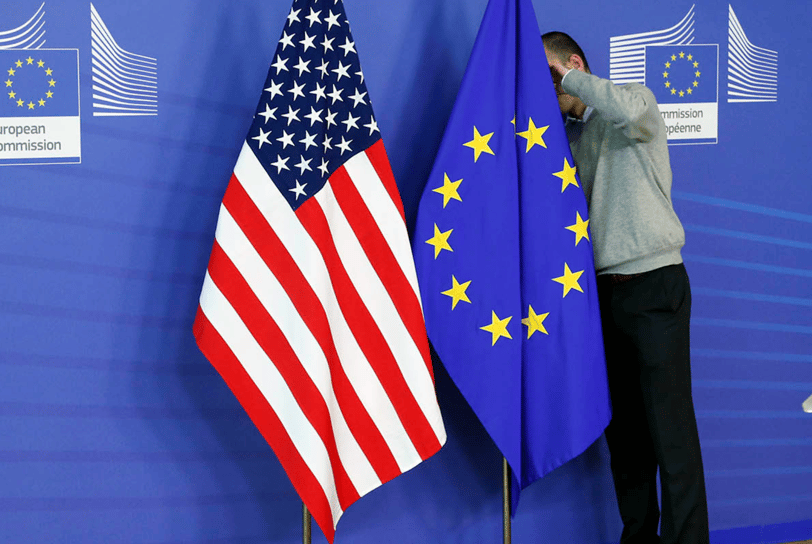Transatlantic Tensions: How U.S.-EU Trade Shapes Global Markets and Local Dreams
6/11/20253 min read


Transatlantic Tensions: How U.S.-EU Trade Shapes Global Markets and Local Dreams
Introduction: The World’s Biggest Trade Partnership
The U.S. and European Union (EU) share the largest bilateral trade and investment relationship globally, with €1.6 trillion in goods and services traded in 2023. This powerhouse partnership supports millions of jobs and drives economic growth, but it’s not without friction. From tariffs to geopolitical shifts, U.S.-EU trade dynamics ripple into global markets and local communities, much like the U.S.-China tensions seen in Green Charter Township, Michigan. This blog explores the complexities of U.S.-EU trade, drawing parallels to how global trade impacts small-town America.
A Deeply Integrated Trade Relationship
Massive Trade Flows: In 2024, U.S.-EU goods trade hit $975.9 billion, with U.S. exports at $370.2 billion and imports at $605.8 billion, creating a $235.6 billion U.S. trade deficit. Services trade reached €746 billion in 2023, with the EU running a €109 billion deficit.
Mutual Dependence: The EU is the U.S.’s top export market, while the U.S. is the EU’s largest trading partner, accounting for 20.6% of EU goods exports and 13.7% of imports in 2023. Key U.S. exports include mineral fuels ($108.94 billion) and pharmaceuticals ($37.89 billion), while the EU supplies machinery and chemicals.
Tariffs and Tensions
Trump’s Tariff Legacy: In 2018, U.S. tariffs on EU steel and aluminum (25% and 10%) sparked retaliatory EU duties on American bourbon and motorcycles. By 2025, Trump’s proposed 20% “reciprocal” tariffs were paused until July, but doubled steel tariffs (to 50%) raised EU concerns.
EU’s Response: The EU, wary of a trade war, prepared countermeasures and paused its own duties to negotiate. Talks intensified, with U.S. and EU trade representatives agreeing to speak bi-daily in May 2025.
The Green Charter Parallel: Global Meets Local
Gotion’s Lesson: Like the U.S.-China trade war fueling Green Charter’s rejection of a Chinese battery factory, U.S.-EU trade tensions highlight local fears of foreign influence. In Green Charter, mistrust of China’s Gotion stalled 2,350 jobs. Similarly, EU farmers oppose the EU-Mercosur deal, fearing cheap imports, echoing protectionist sentiments.
Local Impact: U.S.-EU trade supports jobs, like a Texas company earning 40% of revenue from EU sales. But tariffs risk disrupting these benefits, much as Green Charter’s “No Gos” feared economic and cultural loss.
Geopolitical and Strategic Shifts
Trade and Technology Council (TTC): Launched in 2021, the TTC fosters U.S.-EU cooperation on tech and trade, aiming to counter China’s influence and align on shared values. Its future is uncertain under protectionist policies, with experts warning of a potential trade war if Trump pushes tariffs.
China’s Shadow: Both regions face pressure from China’s trade practices. The EU fears Chinese goods flooding its markets if U.S. tariffs redirect trade, similar to 2017-2019 patterns. This mirrors Green Charter’s CCP fears, showing how global rivalries shape local debates.
Economic Impacts and Opportunities
U.S. Perspective: Tariffs could cut EU GDP by 0.2% and raise consumer costs, but the U.S. benefits from EU critical supplies like pharmaceuticals (33.2% of EU exports in 2023). The TTC could harmonize regulations, boosting industries like clean tech.
EU Perspective: Ireland and Italy face high exposure to U.S. tariffs, especially in chemicals and transport. Yet, the EU’s pursuit of deals with Mercosur and India shows resilience against U.S. protectionism.
Looking Ahead: Cooperation or Conflict?
Negotiation Push: A “six-week sprint” for a U.S.-EU trade deal began in May 2025, aiming to resolve tariff disputes before the July deadline. A comprehensive agreement could stabilize ties, but protectionism threatens progress.
EU’s Strategy: Under Ursula von der Leyen, the EU seeks new trade partners to offset U.S. tariffs, with deals like Mercosur gaining traction despite farmer protests. This mirrors small towns seeking economic wins while navigating global fears.
Conclusion: Bridging the Atlantic
U.S.-EU trade is a cornerstone of global commerce, but tariffs and protectionism threaten its stability. Just as Green Charter grappled with Gotion’s factory, U.S.-EU tensions test how global trade aligns with local priorities. Transparency, as seen in smoother Gotion projects elsewhere, could ease fears. A stronger TTC or new trade framework could prevent a transatlantic trade war, ensuring both sides thrive. Can the U.S. and EU find common ground, or will protectionism fracture this vital partnership?
Thought-Provoking Questions
How can the U.S. and EU balance protectionist policies with the benefits of their integrated trade relationship?
What lessons from Green Charter’s resistance to foreign investment can inform U.S.-EU trade negotiations?
Can the TTC evolve to counter China’s influence without sparking a broader trade war?
Sources: NPR (web:0), EU Commission (web:0), USTR (web:2, web:3, web:14), Investopedia (web:4), Consilium (web:5), ING Think (web:9), BBC (web:10), CSIS (web:11), Euractiv (web:12), Bruegel (web:13), Politico (web:15, web:16), GIS Reports (web:17), Newsweek (web:18), Yahoo Finance (web:19), EBSCO (web:20), Atlantic Council (web:21, web:24), Center for American Progress (web:23), X posts (post:0, post:1, post:2, post:3, post:5, post:6, post:7)
Explore deep insights on current events and growth.
Vision
Truth
hello@insightoutvision.com
+1-2236036419
© 2025. All rights reserved.
